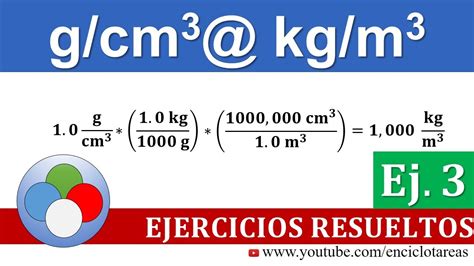Kg M 3 To G Cm3
Juapaving
Apr 03, 2025 · 4 min read

Table of Contents
Kg/m³ to g/cm³: A Comprehensive Guide to Unit Conversion
Understanding unit conversions is crucial in various scientific and engineering fields. This comprehensive guide delves into the conversion between kilograms per cubic meter (kg/m³) and grams per cubic centimeter (g/cm³), two common units for density. We'll explore the conversion process, provide practical examples, and explain the underlying principles to solidify your understanding.
Understanding Density and its Units
Density is a fundamental physical property that describes the mass of a substance per unit volume. It's essentially how tightly packed the matter is within a given space. The formula for density is:
Density = Mass / Volume
Different units can express density, with kg/m³ and g/cm³ being particularly prevalent. Kilograms per cubic meter (kg/m³) is the standard unit in the International System of Units (SI), while grams per cubic centimeter (g/cm³) is frequently used in various applications, especially when dealing with smaller volumes or substances with higher densities.
The Conversion Factor: Unraveling the Relationship
The conversion from kg/m³ to g/cm³ is based on the relationship between kilograms and grams, and meters and centimeters. Let's break it down:
- Mass: 1 kilogram (kg) = 1000 grams (g)
- Length: 1 meter (m) = 100 centimeters (cm)
Since density involves volume (length cubed), the conversion for volume becomes:
1 cubic meter (m³) = (100 cm)³ = 1,000,000 cubic centimeters (cm³)
Therefore, the conversion factor from kg/m³ to g/cm³ is:
(1000 g/kg) / (1,000,000 cm³/m³) = 1/1000 = 0.001
This means that 1 kg/m³ is equal to 0.001 g/cm³. Alternatively, 1 g/cm³ is equal to 1000 kg/m³.
Step-by-Step Conversion Process
The conversion process is straightforward:
-
Identify the initial value: Determine the density value you want to convert, expressed in kg/m³.
-
Apply the conversion factor: Multiply the initial value by the conversion factor (0.001) to obtain the equivalent density in g/cm³.
-
Verify the result: Ensure the converted value makes sense within the context of the substance's density.
Illustrative Examples
Let's work through a few examples to illustrate the conversion process:
Example 1: Converting Density of Water
The density of water is approximately 1000 kg/m³. To convert this to g/cm³:
1000 kg/m³ * 0.001 g/cm³/kg/m³ = 1 g/cm³
This confirms the well-known density of water: 1 g/cm³.
Example 2: Converting Density of a Metal
The density of a certain metal is measured as 2700 kg/m³. To convert this to g/cm³:
2700 kg/m³ * 0.001 g/cm³/kg/m³ = 2.7 g/cm³
Example 3: Converting Density of a Gas
The density of a particular gas is 1.2 kg/m³. Converting this to g/cm³:
1.2 kg/m³ * 0.001 g/cm³/kg/m³ = 0.0012 g/cm³
Practical Applications
The ability to convert between kg/m³ and g/cm³ is essential in diverse applications, including:
- Material Science: Comparing the densities of different materials to select the most appropriate one for a specific application.
- Chemical Engineering: Designing and optimizing chemical processes involving fluids with varying densities.
- Civil Engineering: Calculating the weight and stress on structures based on the density of building materials.
- Environmental Science: Assessing the density of pollutants in water or air.
- Physics: Solving problems involving buoyancy and fluid mechanics.
Avoiding Common Mistakes
While the conversion is relatively simple, a few common mistakes should be avoided:
- Incorrect Conversion Factor: Using the wrong conversion factor can lead to significant errors. Remember the factor is 0.001 (or 1000 in the reverse conversion).
- Unit Inconsistency: Ensure that all units are consistent throughout the calculation. Mixing up prefixes (e.g., kilograms and milligrams) will yield inaccurate results.
- Mathematical Errors: Double-check your calculations to prevent simple arithmetic mistakes.
Advanced Considerations
For more complex scenarios involving unit conversions, it's helpful to use dimensional analysis. This systematic approach ensures that units cancel correctly, leading to the desired unit in the final answer.
Conclusion
The conversion from kg/m³ to g/cm³ is a fundamental skill in many scientific and engineering disciplines. Mastering this conversion enhances your understanding of density and facilitates accurate calculations in various applications. By following the step-by-step process, using the correct conversion factor, and being mindful of potential errors, you can confidently perform this conversion and utilize the results in your calculations and analyses. Understanding the underlying principles behind the conversion will improve your overall comprehension of unit conversions and their significance in scientific and engineering problem-solving. Remember to always double-check your work and ensure that your final answer is reasonable within the context of the problem.
Latest Posts
Latest Posts
-
Changes Of State Occur When There Is A Change In
Apr 04, 2025
-
8 Centimeters Is How Many Millimeters
Apr 04, 2025
-
Does Constant Velocity Mean 0 Acceleration
Apr 04, 2025
-
Venn Diagram Photosynthesis And Cellular Respiration
Apr 04, 2025
-
Predict The Major Product Of The Following Reaction
Apr 04, 2025
Related Post
Thank you for visiting our website which covers about Kg M 3 To G Cm3 . We hope the information provided has been useful to you. Feel free to contact us if you have any questions or need further assistance. See you next time and don't miss to bookmark.
